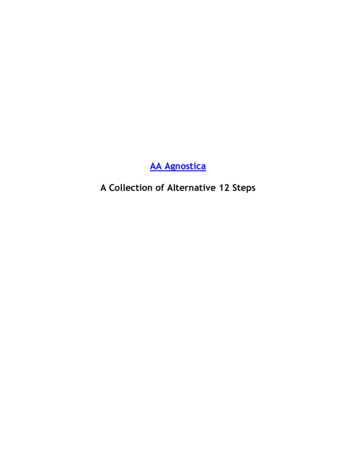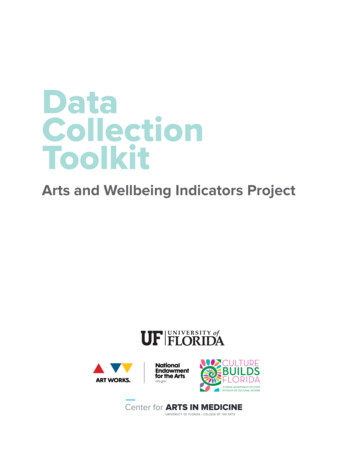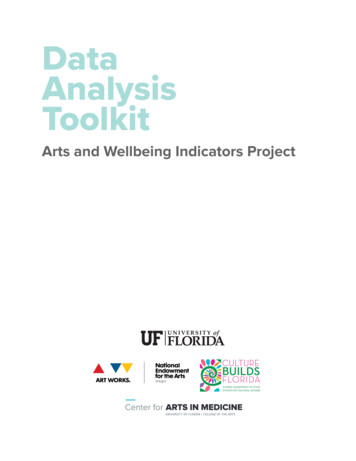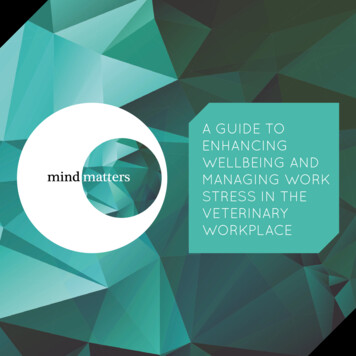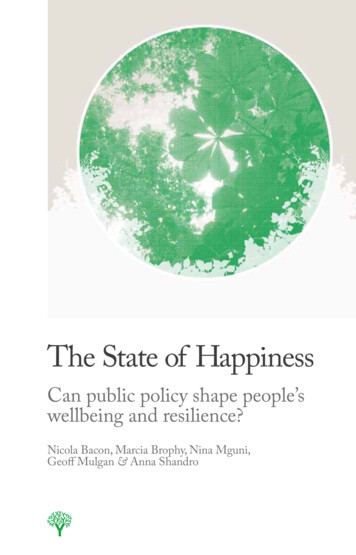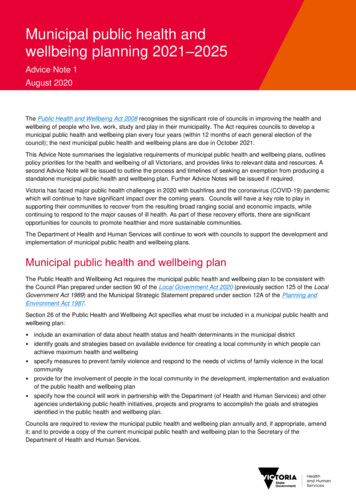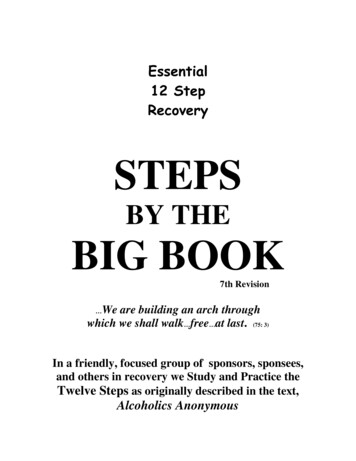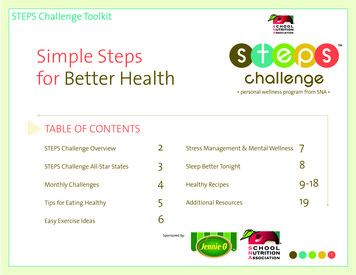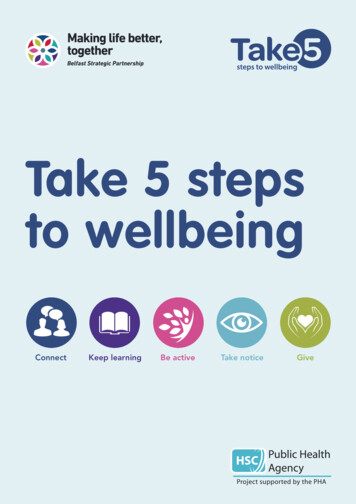
Transcription
Take 5 stepsto wellbeingConnectKeep learningBe activeTake noticeGive
ContentsForeword3What is Take 5 steps to wellbeing?7Take 5 steps to wellbeing10Practical examples of Take 5 steps to wellbeing12Take 5 steps to wellbeing tools16A guide for practitioners17Supporting behaviour change18What Take 5 activities will you do?20My Take 5 steps to wellbeing self-assessment - part 126My Take 5 steps to wellbeing self-assessment - part 227Take 5 steps to wellbeing star28Take 5 steps to wellbeing readiness ruler30My Take 5 steps to wellbeing pledge31Take 5 reminder card32Take 5 steps to wellbeing in your community34What is already available in your community?35Take 5 steps to wellbeing community calendar37Take 5 steps to wellbeing community mapping tool38Take 5 steps to wellbeing community project planning tool39Take 5 steps to wellbeing in your organisation40The benefits of Take 5 steps to wellbeing for your organisation41Using Take 5 steps to wellbeing in your organisation43Promoting Take 5 steps to wellbeing44Take 5 steps to wellbeing organisational audit tool46Take 5 steps to wellbeing organisational planning tool47Take 5 steps to wellbeing organisation pledge48Take 5 steps to wellbeing Evaluation49Evaluation50Take 5 steps to wellbeing Appendices55Take 5 steps to wellbeing branding guidelines56Take 5 leaflets, posters and wallet cards58
ForewordBelfast Strategic Partnership (BSP) through its Mental Health and Emotional Wellbeing ThematicGroup has worked diligently over the last 3 years developing and embedding the Take 5 steps towellbeing approach into its work. Information sessions, activities and programmes have beendelivered across the community, voluntary, statutory and business sectors throughout the city in orderto promote the Take 5 concept and approach.The Take 5 steps to wellbeing (Connect, Keep learning, Be active, Take notice and Give) approachcontributes to improving wellbeing in its fullest sense, both physically and emotionally, where peoplefeel good and function well.However in Belfast wellbeing is not experienced equally by everyone. Across the city, inequalitiesexperienced by those living in the most disadvantaged areas are clear to be seen, with a gap in malelife expectancy of 9 years when compared with the most affluent areas. When we look to figures forhealthy life expectancy regionally, the differential between the most and least deprived areas widenseven further to 12 years for men and 14 years for women.Tackling and addressing these very complex issues requires a collaborative approach and using ourindividual and collective resources to achieve better health for everyone is our primary goal.And so we commend this Take 5 steps to wellbeing Toolkit. It outlines, demonstrates and providesresources based on evidence. It is designed to enable the community, voluntary, statutory andbusiness sectors to increase awareness, knowledge and uptake of Take 5 steps to wellbeing. With thisresource we want to broaden the range of people using Take 5 in their everyday life while at the sametime contribute to increasing levels of wellbeing.In addition to this Toolkit, resources for individuals and families are also available. All are accessibleonline at www.makinglifebettertogether.com or upon request on 028 9050 2073.We would like to thank all those who contributed to preparing this resource. We believe it representsanother valuable ‘tool’ in the box that practitioners can use as they continue their sterling work insupporting and empowering individuals, families and communities across this city and beyond.Irene SherryChairpersonMental Health and Emotional Wellbeing Thematic Group, Belfast Strategic Partnership3
4
Belfast Strategic PartnershipVisionAll people and communities in Belfast can confidently expect to have access to the opportunities andresources they need to live longer, healthier lives.MissionTo reduce life inequalities and improve the health and wellbeing of people in Belfast by changing the way wework together. We do this by jointly harnessing the enthusiasm, efficiency and experience of our stakeholdersto seek health and wellbeing gains in ways that we cannot do by working alone.Purpose To shape the future health and wellbeing priorities for Belfast To foster and take advantage of strategic opportunities to achieve better health outcomes To work together on areas where we can achieve the most impact To inform and influence future policy development To focus on the prevention of ill-health To develop and deliver an over-arching health and wellbeing action plan for the cityKey PrinciplesTo successfully reduce inequality and address the wider determinants of health we must: Maximise our combined impact by working better together Be accountable to others based on the results of our work Base our decisions and actions on evidence and learning from others Be open to innovative approaches and be prepared to work differently Encourage the active involvement of all stakeholders and strengthen relationships Build on the success of existing partnerships and programmes of work Engage with communities and seek to contribute to Community Planning Make effective use of our collective resources through better joint planning and priority setting Drive equity in health and wellbeing through all of our policies Share our learning to change the way the public sector worksMaking Belfast a Resilient CityWe will work to make Belfast an Emotionally Resilient City by: Building and strengthening existing work which has a positive impact on emotional resilience Undertaking pro-active and active work around prevention, promotion and education Developing and enhancing emotional resilience infrastructure and activity across the city Working with citizens to better understand and value emotional resilience as a concept and notion Promoting emotional resilience programmes as a means of support for individuals Better connecting emotional resilience work and activities across the city, with a focuson disadvantage and inequalities5
All resources are availableto download or upon nsCommunitieswww.makinglifebettertogether.comCall Belfast Health Development Unit on:Tel: 028 9050 2073
What is Take 5 stepsto wellbeing?ConnectKeep learningBe activeTake noticeGiveTake 5 steps to wellbeing is a set of evidence-based public health messages aimedat improving the wellbeing of the whole population. It is based on the Five Ways toWellbeing developed by the New Economics Foundation (NEF) as the result ofresearch undertaken as part of the Foresight Project on Mental Capital and Wellbeing(2008)1. NEF states that if practised regularly the Five Ways to Wellbeing2 willcontribute to improving personal wellbeing.These simple and effective messages are based on solid evidence and draw on a wealth of psychological andeconomic literature from inter-disciplinary work. Take 5 steps to wellbeing leads to a shared understandingthat some actions are best supported by organisations or agencies and communities whilst some are bestachieved by the individual.Evidence indicates it is individuals who practise all ‘5 steps’ who have the highest level of wellbeing regardlessof circumstances. As a practitioner working in your community, you can use Take 5 steps to wellbeing to helpidentify opportunities to promote wellbeing. You can motivate and support people to have a go’ and embracethe Take 5 steps to wellbeing, and you can also use this approach to support yourself.This is a preventative approach. It can be used to support interventions, but it is not an intervention in itsown right to treat the challenges associated with mental ill health.1Foresight Mental Capital and Wellbeing Project (2008). Final Project report. The Government Office for Science, London.2New Economics Foundation (NEF). (2008). Five ways to wellbeing: The evidence. London. nef.7
ConnectConnect with the people around you: family, friends, colleagues and neighbours athome, work, school or in your local community. Think of these as the cornerstones ofyour life and invest time in developing them. Building these connections will supportand enrich you every day.Social relationships are important to support wellbeing and to act as a buffer against mental ill health.People with low levels of social participation and small primary social networks are more likely to experiencecommon mental health disorders. Having a broad social network, connecting and interacting with others canhave a positive benefit on wellbeing. Also the strength of relationships is important, feeling close tosomeone and valued by them with the key message being that giving time and space to both strengthenand broaden social networks is important for wellbeing.Keep learningDon't be afraid to try something new, rediscover an old hobby or sign up for acourse. Take on a different responsibility, fix a bike, learn to play an instrument orhow to cook your favourite food. Set a challenge you will enjoy. Learning new thingswill make you more confident as well as being fun to do.In childhood, learning plays an important role in our social and cognitive development. Learning throughoutour life stages contributes to self-esteem, social interaction and active lives, competence and self-efficacy.Goal setting in adult life, particularly when self-generated and aligned with personal values and motivation,has a postive impact on wellbeing. While not everyone may enjoy learning in some environments or seepositive outcomes, it is the case that the activity of learning in itself has benefits and is important forwellbeing.Be activeGo for a walk or run, cycle, play a game, garden or dance. Exercising makes you feelgood. More importantly, discover a physical activity that you enjoy; one that suitsyour level of mobility and fitness.Regular physical activity is associated with greater wellbeing and lower rates of anxiety and depressionregardless of age. There is evidence that physical activity protects against cognitive decline in later life.There is general consensus that even a single bout of exercise or physical activity of less than ten minutescan improve mood and make people feel better. Activities can also have the benefit of strengtheninginteractions with other people e.g when walking.8
Take noticeStop, pause, or take a moment to look around you. What can you see, feel, smell oreven taste? Look for beautiful, new, unusual or extraordinary things in your everydaylife and think about how that makes you feel.Research has shown that being trained to be aware of senses, thoughts and feelings over 8-12 weeks hasresulted in improved wellbeing for several years2. Being aware of what is taking place in the present leads toa more positive state of mind. Heightened awareness enhances an individual’s self-understanding and allowsan individual to make choices in alignment with his/her own values and intrinsic motivations. Perhaps,unsurprisingly, research into actions that aim to enhance wellbeing have similarly found that goals forbehaviour change need to be aligned with personal values to be successful.GiveDo something nice for a friend or stranger, thank someone, smile, volunteer yourtime or consider joining a community group. Look out as well as in. Seeing yourself,and your happiness, linked to the wider community can be incredibly rewarding andcreates connections with the people around you.Helping, giving and sharing are associated with increased self-worth and positive feelings. Giving stimulatesthe reward system in the brain, making a person feel good and it contributes to gains in cognitive and socialfunctioning, particularly in earlier life, which is important to the development of mental capital andwellbeing. Research has shown that undertaking acts of kindness regularly and over time results in increasedwellbeing2. Feelings of happiness and life satisfaction are associated with active participation in social andcommunity life. For older people, volunteering is associated with more positive affect and meaning in life.It is important to note that sometimes doing one activity will incorporate all of the Take 5 steps to wellbeing,e.g. a walk in the park links with Be Active but also:Connect - meeting people in the parkKeep learning - about the range of plants, trees and wildlife in the parkTake notice - of the sights, sounds and smells in the park including animals and birdsGive - meeting people, sharing and giving of your time and experience to othersFurther ReadingThe above information is based on the evidence for the 5 ways to wellbeing developedby the New Economics Foundation (NEF)2. Five ways to wellbeing: new applications, new ways of thinking Five ways to wellbeing: the evidence Wellbeing at work: a review of the literatureYou can find the full reports atwww.neweconomics.org2New Economics Foundation (NEF). (2008). Five ways to wellbeing: The evidence. London. nef.9
Take 5 steps to wellbeingThe concept of wellbeing comprises two main elements: feeling good and functioningwell. Feelings of happiness, contentment, enjoyment, curiosity and engagement arecharacteristic of someone who has a positive experience of their life.Equally important for wellbeing is our functioning in the world. Experiencing positive relationships, havingsome control over one’s life and having a sense of purpose are all important attributes of wellbeing.Emotional wellbeingConnectMental capitalWellbeinggood feelingsday-to-day andoverall happinessand satisfactionGiveWellbeingTake noticeKeeplearningresilience, self-esteem,cognitive capacity andemotional intelligenceBe activeThe premise of the Take 5 steps to wellbeing approach is that care and treatment to address mental healthissues needs to be balanced with prevention and mental health promotion across the entire population andthat this will result in benefits for the whole community as well as reduce the incidence of mental healthdisorders in the longer term.10
The hypothetical distribution of mental healthacross a populationMoving the population to flourishingPercentageof PopulationCommon MentalDisorderLanguishingModerateMental HealthFlourishingPsychological ResourcesSource: Felicia Huppert (2008)3, Cambridge Wellbeing InstituteThe diagram above shows the hypothetical distribution of mental health across a population. On the left arethose experiencing significant mental health difficulties. Those described as languishing are experiencingdifficulties at a sub clinical level. Most of the population experience moderate mental health and thepopulation at the right are described as flourishing.Huppert (2008)3 suggests that a population wide model that succeeds in shifting the entire population willincrease the number of people flourishing and reduce the number of those experiencing significant mentalhealth difficulties.3Huppert F. (2008). Psychological well-being: evidence regarding its causes and its consequences. London: Foresight Mental Capital and Wellbeing Project 2008.11
Practical examples of Take 5steps to wellbeingShankill Women’s Centre: Crochet ClassCommunity levelThe Centre has incorporated Take 5 steps to wellbeing into a range of programmes for theirbeneficiaries, including a crochet class, aqua aerobics, armchair aerobics, sewing and beading. Thecrochet class was created in 2005 in response to feedback from women using the centre. Theywanted to learn how to crochet and do something together. Many of the items they create aredonated to raise money for the centre.“The women have reported that they enjoyed learning the new skills . and that theirconfidence has grown as they never thought they would be able to make the things they arenow making.”Trish Boyd, Health and Wellbeing Project Manager“I never thought I would be able to learn to crochet but the tutor is so patient with me. Myfamily can’t believe what I can make. My family were worried about me because I didn’t getout much but now I have my class and I have made new friends.” Group userEast Belfast Community Development Agency:World Mental Health Day EventCommunity levelA half-day wellbeing event was held to mark World Mental Health Day 2016 run in partnership withlocal homeless hostels and support providers to attract people with experience of homelessness.Participants received the Take 5 flyer and had the opportunity to take part in free activities underTake 5 steps to wellbeing:Connect - information stands provided the opportunity to meet local service providersKeep learning - healthy cooking workshops and recipes to take homeBe active - yoga and salsa danceTake notice - massage and relaxation workshopsGive - students offering free nail treatments collected donations for a homeless charity“I would like to see more events like this. I have thoroughly enjoyed it. I am now going to go tothe salsa class and the relaxation class next week. It’s broadened my horizons.” Event attendee12
Bridge of Hope: Take 5 Resilience TrainingCommunity levelBridge of Hope, as a department of Ashton Community Trust, delivers holistic health and wellbeingservices to support and encourage wellbeing, with over 18,000 individuals having accessed services.It developed and delivered this course in recent years to mirror the key themes involved in the Take 5campaign.“Take 5 is a simple yet really useful framework for your health and life. The benefits of Take 5 aresignificant if people incorporate this straightforward philosophy into their lives.”Irene Sherry, ACT Head of Victims & Mental Health ServicesThe course involves learning how to use Take 5 at an individual level. It also encourages thedevelopment of maintenance strategies and how to effectively build a ‘5 steps to wellbeing toolkit’ foryour life and circumstances. The training introduces local and practical ways people can use the 5steps, sharing tips and ideas, promoting local services and opportunities that can help integrate Take 5into their lives.“Brilliant workshop, thoroughly enjoyable. I have gained a greater awareness and developed skillsto allow me to deal with life”Course ParticipantWest Belfast Partnership Board: Take 5 in the WestCommunity levelThis was an initiative to localise Belfast Strategic Partnership’s Take 5 campaign in West Belfast andpromote Take 5 to the community. All of the agencies who took part undertook to assertively publicisethe work of other partners to those they were in contact with.A key learning point was the ability to undertake a rapid building of collaboration across the sector atlow/no cost. While the initial focus was on existing activity, a review of the final programme showed30% new or bespoke activity had been generated.“The Take 5 in the West publication was extremely useful as it made it possible for me tonavigate our clients towards community interventions in a non-stigmatizing way focusing onresilience rather than dependency.” Suzi Wilson, Mental Health Hub Co-ordinator.“A legacy has been the strategic focus in one of the core areas of Take 5, namely lifelonglearning. I have established a core group of 12 agencies who are actively involved in using thesame approach to highlight the current good work happening in the west of the city.”Dermot Glackin, WBPB Health and Wellbeing Coordinator13
Belfast Drug and Alcohol Co-ordination Team:Self-care workshop for drug and alcohol workersVoluntary sectorAn event organised by the BDACT Connections Service, for workers addressing drug and alcoholconcerns across statutory and voluntary services, to support their self-care.The event was based on Take 5 steps to wellbeing. It began with an introduction to what Take 5 isand got the participants to think about what they did within each message and how that supportedtheir wellbeing. There was a presentation on self-care and workshops with relaxation techniquesincluding drumming and laughter therapy.“The work these practitioners do is stressful and it can take its toll on their health and emotionalwellbeing. We wanted to get the message across that they can’t be at their best in supportingclients if they don’t support their own wellbeing. Take 5 steps to wellbeing was a great way toframe that message.” Diane McMullan, DACT Connections Service.Belfast Health & Social Care Trust: Top Tips ProgrammeStatutory sectorTop Tips for looking after yourself is a 3-hour training programme developed to enable individuals tobecome more aware of their emotional health and learn more about how to promote and protect it.The programme was recently revised to map the content to the Take 5 steps to wellbeing messages.It offers awareness, insights and skills development to recognise barriers that might inhibit or preventthe person from engaging as fully as possible with Take 5 steps. Workers across the community,voluntary and statutory sectors deliver the programme in local communities.Participants discuss issues around resilience and emotional wellbeing and explore healthy copingstrategies to combat stress, anxiety and low mood. They have reported a greater awareness of how tolook after their emotional health, manage stress levels more effectively and recognise unhealthy waysof coping with the ups and downs of life that needed to change.“I really enjoyed this programme and was surprised to see how much new stuff I learned. I reallyfeel I am in a better position to manage my stress in the future and really appreciated theexercise that has taught me how to deal with unhelpful thoughts!” Programme participant.14
Tackling Awareness of Mental Health Issues (TAMHI):Football 4 Health St Patricks FCCommunity levelFootball 4 Health is a programme that TAMHI developed with the club and their young people tobring Take 5 steps to wellbeing to life, to acknowledge the work being delivered at grassroots leveland to explore and celebrate Take 5.It was delivered the over summer months and its themes were: developing friends and positive relationships with peers (Connect) creating customised resources for young people and parents about looking aftertheir wellbeing (Keep learning) football/activity (Be active) creating a positive fun environment (Take notice) and championing young volunteers (Give)“Young Leaders delivered the programme with experienced coaches and gained a wealth ofexperience and knowledge as well as creating positive peer to peer relationships which helpedpromote positive community leadership.” Joe Donnelly, TAMHI.Take 5 has now been embedded into the day to day running of the club and health and wellbeing hasbecome a key pillar of its future development.“Our club has moved from participation only, which was historically our focus, to a more holisticapproach to developing health and wellbeing and resilience and Take 5 has been the driver.“Patrick Downey St Patricks FC Academy Director.Health Living Centres Alliance: World Mental Health DayCommunity levelDuring World Mental Health Day 2016, seventeen Healthy Living Centres delivered the Take 5 steps towellbeing messages through specific events or by adapting their weekly programmes to introduce thethemes. HLC staff attended a workshop where the implementation plan was discussed. The Allianceproduced Statement Cards for people to state: “My mental health is better when ”, Pledge Cards forpeople to make a personal pledge as to how they could adopt a Take 5 message, large sheets to recordhow best they identify with any of the five aspects of Take 5 and a one page feedback sheet.“Our one page feedback sheet proved very useful in terms of providing people with a quick,no-nonsense method of recording their views on the events and how much they had learnt andbenefited.” Tony Doherty, Regional Coordinator, Healthy Living Centres AllianceFeedback data from the 17 centres showed 700 people attended. They provided very positive feedbackon their understanding of Take 5 showing that it was now better and making pledges as to how they willincorporate Take 5 into their lives. The activity has embedded Take 5 into the mental health remits of theHealth Living Centres and buoyed the role of the Mental Health Working Group.“It made me feel less isolated, both physically and mentally. I had an opportunity to connect withothers who were there for the same reasons and hear their stories which made me realise mysituation is not unique.” Event Participant.15
Take 5 steps to wellbeingtoolsThe rest of this booklet is divided into the following sections: Take 5 steps to wellbeing - a guide for practitioners Take 5 steps to wellbeing in your community Take 5 steps to wellbeing in your organisation Evaluation AppendicesEach of the three sections - practitioners, communities and organisations - include a range of tools with anexplanatory note on each one. These tools are to help you to promote Take 5 and to incorporate it into yourwork as well as to get people to start thinking about wellbeing.Some of the tools can be used to complement discussions around ideas and to facilitate conversations withindividuals or groups about how they might include Take 5 in their daily lives. They can also be used to setspecific goals either for individuals, groups or organisations.The Take 5 steps to wellbeing tools can be found in the Practitioners, Communities and Organisationssections on the following pages:Pages 26 to 33 - tools for practitionersPages 37 to 39 - tools for communities Take 5 reminder card Take 5 steps to wellbeing community calendar My Take 5 steps to wellbeingself-assessment - part 1 Take 5 steps to wellbeing community mapping tool Take 5 steps to wellbeing community project planning tool My Take 5 steps to wellbeingself-assessment - part 2Pages 46 to 48 - tools for organisations Take 5 steps to wellbeing star Take 5 steps to wellbeing organisational audit tool Take 5 steps to wellbeing readiness ruler Take 5 steps to wellbeing organisational planning tool My Take 5 steps to wellbeing pledge Take 5 steps to wellbeing organisational pledgeA plain copy of each of the Take 5 tools is available separately. These do not have the explanatorynotes included on them and are, therefore, suitable for printing and sharing.You can also download the tools from:www.makinglifebettertogether.com16
Take 5 steps to wellbeingA guide for practitionersConnectKeep learningBe activeTake noticeGive
Supporting behaviour changeMany people make lifestyle changes without any type of formal support. They will hearthe messages in things like Take 5 steps to wellbeing and make good use of them. For lotsof different reasons, others will not. For these people knowledge alone may not beenough to achieve behaviour change, especially when it comes to lifestyle changes.We can be unsure about change; we can have reasons for making changes but equally reasons against makinga change. It is important to note that uncertainty is normal and our confidence about making any personalchanges is linked to that.People who are uncertain about change have a tendency to present arguments from the opposing side. Therefore,with the best intentions, the practitioner states the reasons for initiating change and the natural tendency of theperson is to state the reasons for not initiating change. They can literally talk themselves out of change.Your approach as a practitionerTo be effective in promoting Take 5 through conversations youhave with people, it will help to look at what you do and how you do it.What works? Open-ended questions: questions that cannot be answered with a 'yes' or 'no' Affirmation: 'you told me you tried to change before - that shows great determination' Normalisation: helps people feel validated and that they are not alone- 'many people tell me they feel like you' Reflective listening: using words to let the person know you have heard what they said- 'so you are saying.' 'it sounds like.' Empathy: let the person know you understand or are trying to understand how it feels for themWhat does not work? Trying to fix things Giving opinions : from you, not theirs Giving advice Adding 'but' in conversations Giving suggestions: from you, not themWhat keeps change going? Self-regulation: they pay attention to whatthey are feeling, thinking and doing Resources: they are aware of their struggleand ways of looking after themselves; rest,sleep, diet, physical activity andrelaxation/fun Building new habits: they build on theirsuccesses and get back on track if they slip Support: there are people and activities thatsupport them in what they want to achieve Motivation: people see the benefits, it fitswith their values and goals18
A model for effective conversationsTo guide more effective conversations we are using the acronym OPEN OCEAN*.“OPEN” (what to do) “OCEAN” (how to do it). It is a guiding, supporting, encouragingstyle of communication (exploring alongside), rather than a directing style(telling, prescribing).Once the person states that they are ready, using planning tools such as those provided later in this guidewill help them make the positive change in their life.OOpportunities:look for theseto start thatconversationPPermission:to ask or giveinformationOCOpen questions:the who, where,how, when andwhat type ofquestions thatopen upconversationConsent:you askpermission to askabout things,give advice orgive informationEExplore:what are theyalready doing,where does it fit,also called activeor reflectivelisteningEEmpathic listening:actively listening,making sure theperson feelsunderstood andcared aboutNNudge:have thatconversationAAffirmations:build onstrengthsNNuggets:of information,advice, signpostingto services alwaysgiven with consentand as optionsfollowed by checkingout what they thinkOffer, Provide, Explore is a model of giving information. Offer (they want it, are able for it, what theyalready know), Provide (neutrally), Explore reactions, questions, next steps.*OPEN OCEAN is a framework developed by Ed Sipler, SEHSCT Health Development / Addic
7 Take 5 steps to wellbeing 10 Practical examples of Take 5 steps to wellbeing 12 . Mental Health and Emotional Wellbeing Thematic Group, Belfast Strategic Partnership 3. 4. 5 Vision All people and communities in Belfast can c

